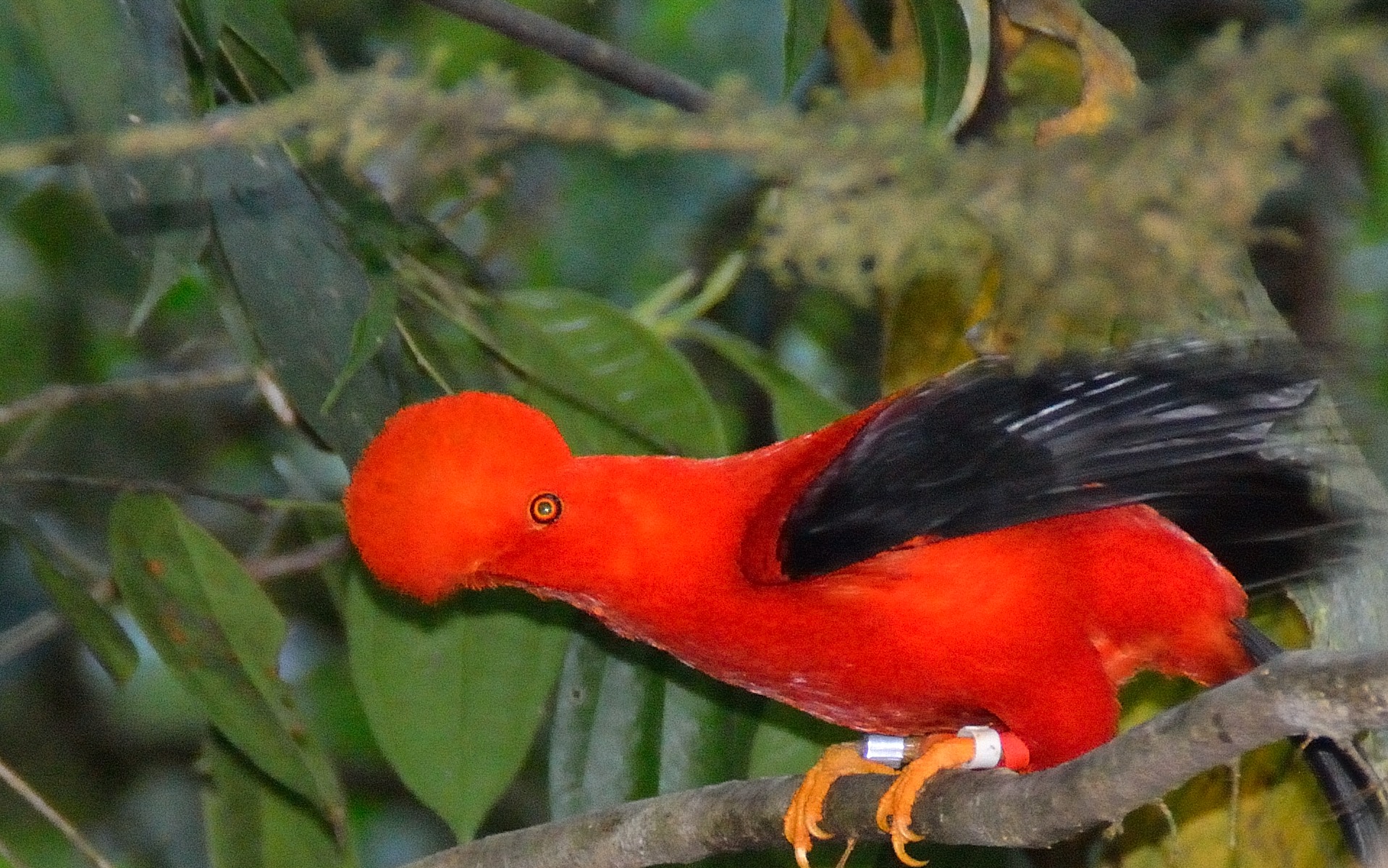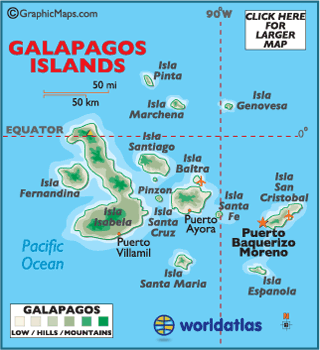From the Galapagos Islands, I flew up to Quito, the capital of Ecuador, which I used as a base for the next five days to explore some more of Ecuador. First I headed a couple of hours northwest to the town of Mindo, which sits at the heart of the Mindo-Nambillo cloud forest a renowned bird watching site due to being home to around 370 species of birds. I´d originally planned to head east to the Amazonian rainforest, but with both time and money now at a premium, I decided to spend a couple of days exploring the slightly more accessible, but no less interesting, cloud forest.
 |
| Mindo-Nambillo cloud forest |
On my first afternoon in Mindo I took a walk uphill out of town until I reached La Terabita, a strange aerial tram which after a slightly precarious ride above the treetops brought me to a series of paths connecting a number of waterfalls deep in the forest. After walking between a few of the waterfalls, I took a quick refreshing dip under one of them before walking back up through the forest to catch the last Terabita ride back towards Mindo.
 |
| La Terabita |
 |
| After a quick dip under one of the waterfalls |
The next day I wandered out of town again, this time to
Mariposas de Mindo, a fantastic butterfly farm that is home to 1200 butterflies from 25 different species. After a brief explanation (in Spanish) of the four stages of a butterfly´s life, I was able to wander around the enclosure the butterflies inhabit. The butterflies were all incredibly colourful and some of them were nearly as big as my hand! A few photos of the best of them are below...
Later that day, I got a slightly more dramatic view of the cloud forest by
zip lining over the trees on a series of zip lines extending 3500m over the forest. In all there were 13 lines ranging from 20m to 450m, which gave a great adrenaline rush as well as fantastic views across the cloud forest.
 |
| Zip lining over the cloud forest |
I then stopped in at
Reservas Las Tangaras, a brilliant but well hidden ecological reserve deep in the forest which I´d spotted a sign for on my walk the previous day. The reserve is a 2km walk from the main road down a steep muddy track so is not visited by many tourists, but it was a great find that I enjoyed wandering around for a couple of hours. The reserve employs a couple of volunteers to run it, who monitor the local wildlife and maintain the network of walking trails that run across the site. On arriving at the cabin which is the volunteers home and which also welcomes paying guests, I found a number of hummingbirds whizzing around the two feeders that sit outside. I stood transfixed for several minutes watching the hummingbirds flying to and from the feeders, feeling privileged to see these beautiful birds in the wild.



I then took a walk along a few of the trails, finding my way to a watering hole in the river where I took another quick swim, before walking up to a bird watching shelter from where you can see the brightly coloured Andean Cock of the Rock bird displaying its colours and squawking loudly at a lek (courting ground).
 |
| Stopping for a swim at Las Tangaras |
 |
| Cock of the Rock Lek (picture taken from the Las Tangaras website) |
After a final walk through the forest the following morning, it was time to say goodbye to Mindo and head back to Quito, after what had been a really good few days exploring the forest. While not as well known as the Galapagos Islands or the Amazon rainforest, the wildlife on display here was equally impressive and I was really glad to have visited the area.
The next day I again headed out of Quito, this time to the Cotopaxi National Park, home of Cotopaxi, the highest active volcano in the world, and one of the highest mountains in Quito. I´d booked to do a 60km mountain biking tour of the park with the
Biking Dutchman, a Dutch guy called Jan who´s been running biking tours in the area for around twenty years. After driving a couple of hours out of Quito, I along with a Colombian couple, Cecil and Valerie, saddled up and set off with Jan for a fantastic ride around the park. At first Cotopaxi was covered in cloud and we thought we might not get a
glimpse that day, but a gap in the clouds soon appeared and were able
to spot the snowy peak above us.
 |
| First view of Cotopaxi |
 |
| Ready to set off |
It was my first time back on a mountain bike since my nasty crash in Bolivia so I was a little hesitant at first, but before long I was zooming down a steep hill and regaining my confidence. Most of the morning´s riding was up a steady incline so it was quite tough going, but made more than worth it by the stunning surroundings of the national park.
 |
| Lunch! |
After stopping beside a lake for lunch, the afternoon saw some easier
riding as we headed downhill towards the northern gate of the park.
Unfortunately the weather began to turn as the afternoon went on and
before long we were heading towards a big thunderstorm which was
throwing big bolts of forked lightning on to the ground below. We
sensibly decided to cut the ride short there as none of us particularly
fancied getting hit by lightning for the sake of a few more kilometres
bike riding
 |
| Cotopaxi |
My final couple of days in Ecuador were spent exploring Quito. First I caught a bus to Mitad del Mundo, a huge monument built to commemorate the role that Ecuador played in better understanding the shape and size of the planet following some work carried out here by French astronomers and scientists in the eighteenth century. The monument was built on what was thought to be the Equator, but was later shown by GPS systems to be around 250m south of the equator! Inside the monument was an interesting museum about the different native tribes in Ecuador while the parkland around the monument contained a number of other exhibitions and attractions.
 |
| Mitad del Mundo |
Following the discovery of the mistaken location of Mitad del Mundo, some enterprising locals have opened another museum on the actual Equator line, which as well as further displays about Ecuador´s history and native people, also offers a number of interesting experiments to demonstrate the differences between the two hemispheres and the effects of being on the Equator. Perhaps inevitably this includes a sink of water so you can watch water going down a plug hole clockwise and anticlockwise either side of the line (and straight down on the Equator itself) as well as a game where you have to balance an egg on a nail (supposedly easier on the Equator) which I failed miserably at!
 |
| A quick trip home to the Northern Hemisphere |
On my last morning in Ecuador I took a wander around the old town of Quito, which contains a huge number of impressive colonial buildings, as well as some more recent buildings, such as the Basilica Cathedral which for a couple of dollars I was able to climb to the top of and get some great views of the city.
 |
| Basilica Cathedral |
 |
| Quito |
Today happened to be 1st May, so from the top of the cathedral I also got some great views of the Labour Day marchers as they came past the cathedral as part of a huge parade of workers through the city. There were lots of police around, helicopters circling overhead and thousands of people out on the streets either participating in the march or watching it go past (Labour Day is a national holiday in Ecuador), and it was interesting to see the various groups come past, including trade unions, the communist party of Ecuador and various other representatives of local and national workers organisations. Thankfully everything seemed to pass off peacefully and the parade didn´t stop me from getting to the airport in time for my flight on to my next and final destination in South America, Rio de Janeiro....
 |
| The Communist Party marchers at the May Day parade |
 |
| Traditional dress and dancing at the May Day parade |























































